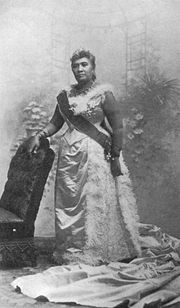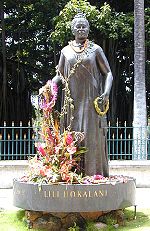
1893 Constitution of the Kingdom of Hawaii
Encyclopedia

1887 Constitution of the Kingdom of Hawaii
The 1887 Constitution of the Kingdom of Hawaii was a legal document by anti-monarchists to strip the Hawaiian monarchy of much of its authority, initiating a transfer of power to American, European and native Hawaiian elites...
, primarily based on the Constitution of 1864
1864 Constitution of the Kingdom of Hawaii
The Constitution of 1864 of the Kingdom of Hawaii was a rewrite of the 1852 constitution issued by King Kamehameha III. It dramatically changed the way Hawaii's government worked by increasing the power of the king and changing the way the kingdom's legislature worked...
put forth by Queen Lili'uokalani. While it never became anything more than a draft, the constitution had a profound impact on Hawaii's history: it set off a chain of events that eventually resulted in the overthrow of the Hawaiian Kingdom.
Background
Prior to 1887, the monarchs of Hawaii ruled the kingdom as executive monarchs. Following the writing of the 1887 Constitution, however, the monarch was reduced to a mere figurehead.During the 1890 legislature, the Hawaiian king, David Kalākaua
Kalakaua
Kalākaua, born David Laamea Kamanakapuu Mahinulani Nalaiaehuokalani Lumialani Kalākaua and sometimes called The Merrie Monarch , was the last reigning king of the Kingdom of Hawaii...
, backed a number of proposals to amend or rewrite the 1887 constitution. However, all of these measures failed.
In 1891, Liliuokalani ascended the throne. In 1892, she backed measures in the kingdom's legislature to amend or rewrite the constitution. However, the measures failed as they had during the reign of her brother. Among the measures that failed was an amendment that would lower the property requirement to vote so most of the general public could vote. When that was voted down, many Hawaiian citizens protested. Thousands petitioned the Queen to issue a new constitution as Kamehameha V
Kamehameha V
aloghaKamehameha V , born as Lot Kapuāiwa, reigned as monarch of the Kingdom of Hawaii from 1863 to 1872. His motto was "Onipa`a": immovable, firm, steadfast or determined; he worked diligently for his people and kingdom and was described as the last great traditional chief...
had done in 1864 (the Constitution of 1864
1864 Constitution of the Kingdom of Hawaii
The Constitution of 1864 of the Kingdom of Hawaii was a rewrite of the 1852 constitution issued by King Kamehameha III. It dramatically changed the way Hawaii's government worked by increasing the power of the king and changing the way the kingdom's legislature worked...
).
The Proposed Constitution

- Members of the privy council, notary public, and agents would be able to run for the legislature.
- Princess KaiulaniKa'iulaniVictoria Kaiulani Kalaninuiahilapalapa Kawēkiu i Lunalilo Cleghorn was heir to the throne of the Kingdom of Hawaii and held the title of crown princess. Kaiulani became known throughout the world for her intelligence, beauty and determination...
, Prince KawānanakoaDavid KawananakoaPrince David Laamea Kahalepouli Kinoiki Kawānanakoa Piikoi , was the patriarch of the House of Kawānanakoa. He was in the line of succession to the throne of the Kingdom of Hawaii around the time of the kingdom's overthrow.-Life:...
and Prince KalanianaoleJonah Kuhio Kalaniana'olePrince Jonah Kūhiō Kalanianaole Piikoi was a prince of the reigning House of Kalākaua when the Kingdom of Hawaii was overthrown by international businessmen in 1893...
would be added to the line of succession. - The Queen would be given the power to call meetings of the legislature.
- The legislature would meet for regular sessions in April instead of May.
- The Queen’s private lands and other property were made inviolable.
- The Queen would sign all bills before they became law. Under the 1887 constitution, any bills vetoed by the Queen and then repassed by the legislature with a two-thirds majority would automatically become law without the signature of the Queen. Under the proposed 1893 constitution, the Queen would be obligated to sign all bills repassed by the legislature with a two-thirds majority.
- The pay of the legislators would be increased to $250 from $500.
- Nobles would be appointed by the Queen instead of elected.
- The number of representatives could be increased from 24 to 48.
- Property requirements for voters were decreased.
- American and European residents, granted suffrage in 1887, would lose the right to vote.
- Supreme court judges would be appointed for six years instead of for life.
- The Queen would be able to appoint governors of each island for four years.
Backlash
.jpg)
Outside, a large crowd of Native Hawaiians had gathered, expecting the Queen to proclaim a new constitution. However, after her meeting with her cabinet, Liliuokalani instead went outside onto the palace balcony and told the crowd that a new constitution would have to wait and that they should peacefully return to their homes.
That evening, a group of the Queen's opponents met to discuss the events of the day. Most were concerned over the Queen's attempt to restore the power of the crown. Some annexationists, like Henry Baldwin
Henry Alexander Baldwin
Henry Alexander Baldwin or Harry Alexander Baldwin was a sugarcane plantation manager, and politician who served as Congressional Delegate to the United States House of Representatives representing the Territory of Hawaii...
, urged moderation but others, like Lorrin A. Thurston
Lorrin A. Thurston
Lorrin Andrews Thurston was a lawyer, politician, and businessman born and raised in the Kingdom of Hawaii. The grandson of two of the first Christian missionaries to Hawaii, Thurston played a prominent role in the overthrow of the Hawaiian Kingdom that replaced Queen Liliuokalani with the...
urged the overthrow of the monarchy. A plan of action was created by the group, including the creation of a Committee of Safety
Committee of Safety (Hawaii)
The Committee of Safety, formally the Citizen's Committee of Public Safety, was a 13-member group of the Hawaiian League also known as the Annexation Club...
, the overthrow of the monarchy, the establishment of a provisional government, and the petitioning for annexation to the United States
United States
The United States of America is a federal constitutional republic comprising fifty states and a federal district...
.
The following Monday, the Queen issued a statement saying that she would not attempt to amend the constitution except by the means provided in the 1887 constitution. However, the Committee of Safety did not believe her promise was sincere, and continued with their planning. A group of men mostly drawn from the ranks of the Reform Party of the Hawaiian Kingdom formed the Committee of Safety and asked the United States Minister, John L. Stevens
John L. Stevens
John Leavitt Stevens was the United States Department of State Minister to the Kingdom of Hawaii in 1893 when he was accused of conspiring to overthrow Queen Liliuokalani in association with the Committee of Safety, led by Lorrin A. Thurston and Sanford B...
, to land troops from the U.S.S. Boston (anchored in Honolulu Harbor) into Honolulu, to protect American lives and property. John L. Stevens
John L. Stevens
John Leavitt Stevens was the United States Department of State Minister to the Kingdom of Hawaii in 1893 when he was accused of conspiring to overthrow Queen Liliuokalani in association with the Committee of Safety, led by Lorrin A. Thurston and Sanford B...
, reacting to what he saw as potential unrest as the internal crisis continued, requested the landing of about 160 Marines
United States Marine Corps
The United States Marine Corps is a branch of the United States Armed Forces responsible for providing power projection from the sea, using the mobility of the United States Navy to deliver combined-arms task forces rapidly. It is one of seven uniformed services of the United States...
, who were given specific orders by Captain G. C. Wiltse to "land in Honolulu for the purpose of protecting our legation, consulate, and the lives and property of American citizens, and to assist in preserving public order." At 2:00pm on January 17, 1893, a proclamation was read on the steps of Government building, declaring the monarchy overthrown. U.S. peacekeepers were at the time stationed at Arion Hall, the U.S. Consulate, and the U.S. Legation, under orders of strict neutrality and out of any potential line of fire between the Provisional Government and Royalist forces. The Queen abdicated under protest ostensibly "to the superior force of the United States government", though her surrender was delivered to the Provisional Government, not the United States. The Kingdom of Hawaii had ended, and a new provisional government
Provisional Government of Hawaii
The Provisional Government of Hawaii abbreviated "P.G." was proclaimed on January 17, 1893 by the 13 member Committee of Safety under the leadership of Sanford B. Dole...
was declared.
The Provisional Government quickly gained recognition from the United States Government and all the other governments with embassies in Hawaii, but was opposed by the administration of Grover Cleveland
Grover Cleveland
Stephen Grover Cleveland was the 22nd and 24th president of the United States. Cleveland is the only president to serve two non-consecutive terms and therefore is the only individual to be counted twice in the numbering of the presidents...
for years as he attempted to restore the monarchy, beginning with the Blount Report
Blount Report
The Blount Report is the popular name given to the part of the 1893 United States House of Representatives Foreign Relations Committee Report regarding the overthrow of the Kingdom of Hawaii. The report was conducted by U.S. Commissioner James H. Blount, appointed by U.S...
. President Grover Cleveland
Grover Cleveland
Stephen Grover Cleveland was the 22nd and 24th president of the United States. Cleveland is the only president to serve two non-consecutive terms and therefore is the only individual to be counted twice in the numbering of the presidents...
, in a message to Congress on December 18, 1893, denounced the actions of Minister Stevens, the Honolulu Rifles and the Committee of Safety as an "act of war, committed with the participation of a diplomatic representative of the United States and without authority of Congress." Following the Morgan Report
Morgan Report
The Morgan Report was an 1894 report concluding an official U.S. Congressional investigation into the events surrounding the overthrow of the Hawaiian Kingdom, including the alleged role of U.S. military troops in the overthrow of Queen Liliuokalani...
submitted by Congress on February 26, 1894, Cleveland reversed his stance, rebuffed the Queen's further requests for interference in the matter, and acknowledged the Provisional Government as legitimate.
Liliuokalani's trial
In 1895, an abortive attempt by Hawaiian royalists to restore Queen Liliuokalani to power resulted in the queen's arrest. She was forced to sign a document of abdication that relinquished all her future claims to the throne. Following this, she was subject to a public trialPublic trial
Public trial or open trial is a trial open to public, as opposed to the secret trial. The term should not be confused with show trial.-United States:...
before a military tribunal in her former throne room.
Convicted of having knowledge of a royalist plot, Liliuokalani was fined $5000 and sentenced to five years in prison and hard labor. The sentence was commuted to imprisonment in an upstairs bedroom of Iolani Palace. During her imprisonment, the queen was denied any visitors other than one lady in waiting. She began each day with her daily devotions followed by reading, quilting, crochet-work, or music composition.
After her release from Iolani Palace, the queen remained under house arrest for five months at her private home, Washington Place. For another eight months she was forbidden to leave Oahu before all restrictions were lifted.

